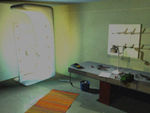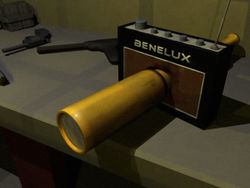Megaloscope
The Megaloscope is a fairly recent invention. It only dates back to 14. of March 1998, when professor emeritus Emeritus Doff came up with the groundbreaking idea of using gamma rays for turning the Universe into a lens for his radiotelescope. As the Universe is infinite, or practically so, the Megaloscope can detect anything from any distance and also magnify anything to any scale. Since Doff's invention there have been no secrets in the Universe.
“I can take the picture of this flea here and blow it up to GIGANTIC proportions. We can make an advertisement on a skyscraper wall out of an atom. We can see farther than the Moon and even further than that. Then I will blow you all to, er, a better place.”
– Emeritus Doff, the inventor of Megaloscope
History[edit | edit source]
While the ordinary retroscope is a magnificent invention, it started annoying some scientists around the year 1950, a few years after the atom had been split. Everybody wanted to see the atom actually split, and not just get cancer from the radiation. Some scientists, most notably Walt Spanker (1901-1952) started hankering after more powerful optical aids. The electron retroscope was all too powerless in his opinion. To quote Spanker:
- "Two million times my arse! What the hell can I do with a magnification of 1 : 2000000 - or 2000000 : 1 for that matter? It's kid stuff, you can keep it. I need to see electrons, protons, neutrons, neutrinos, positrons, and oedipal quarks!"
The emergence of Anyscope[edit | edit source]
While some of the more conservative scientists didn't quite agree on Spanker's choice of vocabulary[1], most were in accord with his view on seeing things. With the aid of his colleagues, Spanker started looking for people with technical expertise for building anything. In 1951, the group of scientists traveled to Disneyland, where the props were said to be really expensive. They never even got to see the props, since their budget fell through. The plan to build an Anyscope - as Hans Libertine coined it - couldn't be realised. Walt Spanker apparently had built his hopes on seeing things more clearly, and lost all will to live.
After Walt Spanker's untimely death, the idea of Anyscope was lost to mankind for almost two decades. There was no useful scientific theory to back up the wild dream, and everybody naturally lost interest. In 1970, however, master machinist Rickard Benson happened to go through Spanker's diaries and saw his bitter remark:
- "The decade has been a failure to me and to mankind. What's the use of trying? I'm so fed up with trying to decipher anything with these retroscopes. There's nothing retroscopic about them but their magnification power. I wish I could have built that Anyscope! Curse this world and the maggots that squirm upon it, the seething mass of brainless morons! I'll show you yet! You will bitterly regret the day you didn't let me built the Anyscope! Keep your budget, you miserable cowards! I will meet you in Hell and stuff you with burning, poisonous banknotes, you blithering idiots!"
Benson had a hunch he was onto something big, very big. He quit his day job and interviewed Spanker's closest friends and colleagues, which took him the better part of a year. Most of them suggested Benson should go and see Emeritus Doff, the prime scientist singlehandedly treading the field of Optomedical science. One of them kindly provided Benson with the story behind the mysterious name "Anyscope", and Benson took off. In 1968, Benson traveled to Caliphornia to meet Doff, who hired him on the spot, and the two started on a path that would change their lives. This time, budget was not a problem: Doff had friends in high places - friends who benefited vastly from his experience with psychochemical tampering.

From Anyscope to Largerer[edit | edit source]
By the spring of 1977, after numerous false starts, Emeritus Doff and Rickard Benson had managed to build an instrument that was just like a big telescope, but looked like a fridge. After a long quarrel, they named it "The Largerer". As both were disappointed with the name as well as the contraption (it only magnified 17 million times and went bust right after that) it was promptly dismantled. Doff was furious: he was a man who wasn't used to failure. He was on the brink of terminating his life, and thereupon his career, but Benson glibly cajoled him into continuing the project. After the initial shock had worn off, Doff quickly understood the reason for the failure: he hadn't aimed high enough.
From Largerer to Megaloscope[edit | edit source]
In 1978, Emeritus Doff inherited a radiotelescope from his uncle, who happened to die - a coincidence, natural reasons. It didn't take Doff long to understand that the telescope was comparably powerless without a universal force to drive it. It took him twenty years to harness all of the Universe - with the help of mystical gravity, astral plane, ley lines, the fourth dimension driving the fifth, and electromagnetic duodecimal distraction - for the use of his "mother of all magnifying glasses". He only needed to add a few spare parts from some borrowed machinery and a few lenses to create an instrument that was, in his words, capable of doing whatever he wanted it to do. Benson dubbed the machine "Megaloscope", and the name stuck.
The theory and practice of megaloscopy[edit | edit source]
Mathematical proof[edit | edit source]
In the words of Emeritus Doff:
- "The exact mathematical formula for the path of rays passing through the lenses of the Megaloscope is all too complicated for the layman to understand, not to mention the average scientist. Only someone like me, whose brain has been enlargenified by the Megaloscope, can be brilliant enough to see the light. I don't need to prove anything, do you understand? When I'm ready so strike... the match of science, I mean... you will all understand the power of my brain. MY BRAIN."
The function of the Megaloscope outlined[edit | edit source]
The metamagnetic fields of the fifth dimension play an important part in the workings of a Megaloscope. Their curvature determines 80% of the workings of the sub-atomic particles that deviate the mass of the Universe from the light that goes through the lenses. The infernal combustion engine pumps the red thing full of steam[2]. As a result, a deadly ray is developed. The ray is aimed out, towards the universe, which turns it harmlessly back after filling it with information. The information travels back through the lenses and the steam. It is decoded by an ordinary perpetual motion machine connected to a telefax.
International law vs. megaloscopy[edit | edit source]
Several lawsuits have been raised against Emeritus Doff. The scientific community appears to be afraid of his methods. Some envious, cowardly little professors are always trying to hamper his plans. Doff has repeatedly told them that world domination is not part of his plans, and that the Megaloscope is NOT a weapon, but do these wimps listen to him? Guess again. So far, Doff has managed to slip through their clutches[3] by claiming universal untouchability. In short, this means he can do whatever he pleases. The highest of the high courts hasn't yet announced its decision, and we remain hopeful it will take its time until Doff is ready.
The present and the immediate future[edit | edit source]
Today there are still only two (2)[4] Megaloscopes working. The other is owned by Emeritus Doff, and the other by the Government[5]. Doff is, as far as is known, trying to see infinitely small things with the infinite magnifying capacity of the 'scope, but so far he has only managed to see things "microscopically microscopic"[6]. Why the infinitely small has escaped him[7] seems to be a mystery, but he has a theory:
"The infinitely small things are so small that to them, any space is infinite. If I wanted to see a thing infinitely small, I would have to look forever and a day, obviously. But I will not quit trying. I want my name in history books as the man who almost saw almost nonexistent things. This really is only a magnifying glass, you know. Nothing more."
The latest developments[edit | edit source]
Since the writing of the previous parts of this article, Emeritus Doff has vanished. Various diplomats tried to contact him in his Megalovault in southern Mexico, but to no avail. The latest reports mention "huge areas of burning forest, vast land masses turned upside down, millions of dead birds and a strange portal into another dimension". This can only be propaganda. Doff was a great humanitarian scientist, he seriously only wanted to help mankind. If he has vanished, it's the fault of the envious majority of feeble-brained, bureaucratic professors not worthy of washing Doff's decanters.
Footnotes[edit | edit source]
- ↑ Nobody understood the word quark.
- ↑ Vaporized water.
- ↑ A hatch of eggs.
- ↑ A couple of them.
- ↑ We cannot tell which government but we would if we knew.
- ↑ Microscopic is something we see with a microscope. Microscopically microscopic is something we see with a microscopic microscope. Since there is no practical way to build one, the Megaloscope is the only obvious solution to the problem. Is it clear now?
- ↑ The Spiteworm is the smallest thing that Doff has managed to see with his 'scope.




